For many dog lovers, the joy of pet ownership is often overshadowed by persistent allergies. The idea of a “hypoallergenic” dog has gained immense popularity, offering a glimmer of hope for individuals sensitive to pet dander. While no dog is truly 100% allergen-free, certain breeds are known for producing less dander and shedding minimally, making them a much more manageable option for allergy sufferers. If you’re specifically looking for a canine companion that’s not too big, not too small, and won’t leave a trail of hair across your home, then medium sized dogs that don’t shed hair are likely at the top of your list.
This comprehensive guide explores the best medium-sized, low-shedding dog breeds, delves into what makes a dog “hypoallergenic,” and provides essential tips for living harmoniously with your new, allergy-friendly friend. Discovering the right breed can make all the difference in creating a loving home for both you and your pet.
Understanding “No-Shed” and Hypoallergenic Dogs
The term “hypoallergenic” can be misleading. It implies an absence of allergens, which isn’t entirely accurate when it comes to dogs. All dogs produce allergens, primarily found in their dander (flakes of dead skin), saliva, and urine. These tiny particles are what trigger allergic reactions in sensitive individuals, leading to symptoms like sneezing, itching, watery eyes, or even asthma.
So, what makes a dog “hypoallergenic” in practical terms? It generally refers to breeds that:
- Shed minimally: Less shedding means fewer allergen-carrying hairs and dander are released into the environment. These dogs often have coats that are more like human hair than typical fur, growing continuously and requiring regular grooming rather than seasonal shedding.
- Produce less dander: While all dogs produce dander, some breeds are believed to produce less or have dander that is less potent as an allergen.
It’s crucial to understand that even with these breeds, some level of allergen will always be present. Regular cleaning, grooming, and sometimes medication are still necessary for severe allergy sufferers. However, for many, these low-shedding options significantly reduce the frequency and severity of allergic reactions, making dog ownership a tangible reality. If you’re exploring options beyond medium-sized companions, you might also be interested in a small breed of dog that doesn’t shed.
What Qualifies as a Medium-Sized Dog?
Defining “medium-sized” can vary slightly, but generally, these dogs fall within a specific range of height and weight, offering a good balance between a small lap dog and a large breed that requires significant space.
- Weight: A medium-sized dog typically weighs between 20 to 60 pounds.
- Height: Their height, measured at the shoulder, usually ranges from 18 to 25 inches.
Dogs in this category are often versatile, adaptable to various living situations from apartments (with adequate exercise) to larger homes, and are robust enough for active families while still being manageable.
Top Medium Sized Dogs That Don’t Shed Hair
Choosing a medium-sized, low-shedding dog means looking for breeds with specific coat types—often curly, wiry, or single-coated—that trap loose hair and dander rather than releasing it into the environment. Here are some of the most popular and highly recommended options:
1. Standard Poodle
 White Standard Poodle walking through lush green grass
White Standard Poodle walking through lush green grass
The Poodle is perhaps the most iconic “hypoallergenic” dog, and for good reason. Standard Poodles, in particular, are elegant and intelligent dogs known for their distinctive curly, dense coats that shed very little. Originally bred as water retrievers in Germany, they are highly trainable, active, and loyal companions.
- Size: Standard Poodles typically weigh 45-70 pounds and stand over 15 inches tall at the shoulder. Miniature Poodles also fall into a small-medium category, weighing 10-15 pounds and standing 10-15 inches.
- Temperament: Highly intelligent, active, and eager to please. They are generally good with families and children, thriving on mental and physical stimulation.
- Grooming: Their non-shedding coat requires consistent maintenance to prevent matting. Weekly brushing and professional grooming every 4-6 weeks are essential.
2. Standard Schnauzer
 Gray Standard Schnauzer standing alert in a grassy field
Gray Standard Schnauzer standing alert in a grassy field
The Standard Schnauzer is a robust and intelligent breed known for its distinctive beard, bushy eyebrows, and wiry coat. Falling squarely into the medium-sized category, these dogs are energetic, alert, and make excellent watchdogs. Their double coat, consisting of a hard, wiry outer coat and a soft undercoat, sheds minimally.
- Size: Standard Schnauzers typically weigh 35-50 pounds and stand 17.5-19.5 inches tall.
- Temperament: Loyal, protective, and lively. They are intelligent and strong-willed, requiring consistent training and plenty of exercise to keep them happy and well-behaved.
- Grooming: Their wiry coat benefits from regular brushing (2-3 times a week) and hand-stripping or professional clipping every few months to maintain its texture and minimize shedding.
3. Portuguese Water Dog
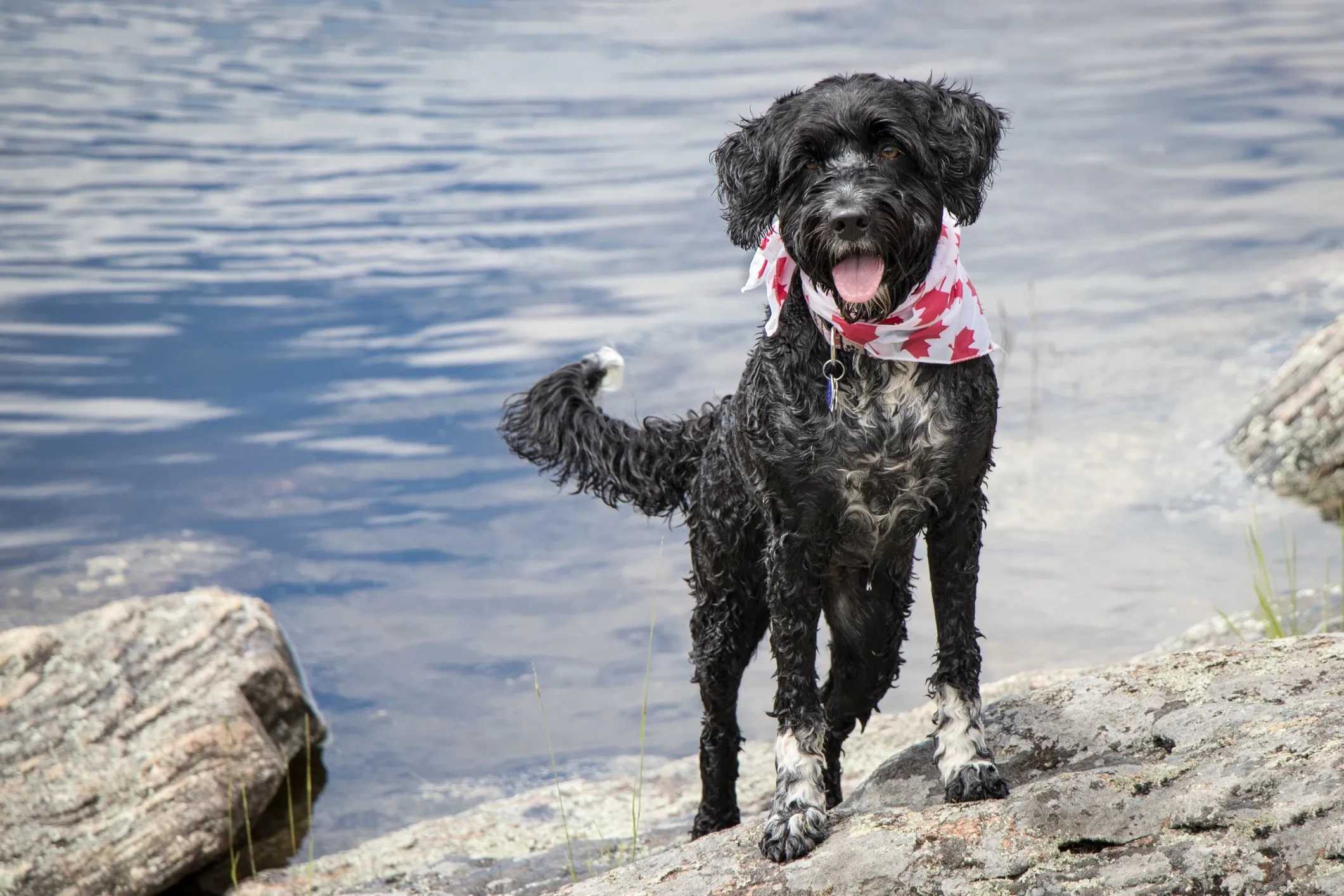 Black and white Portuguese Water Dog wearing a red bandana in front of a calm body of water
Black and white Portuguese Water Dog wearing a red bandana in front of a calm body of water
As their name suggests, Portuguese Water Dogs are natural swimmers and were originally bred to assist fishermen. They possess a thick, curly, waterproof coat that sheds very little, making them an excellent choice for allergy sufferers. These dogs are highly intelligent, energetic, and thrive on activity and companionship.
- Size: Portuguese Water Dogs typically weigh 35-60 pounds and stand 17-23 inches tall.
- Temperament: Affectionate, intelligent, and spirited. They are eager to please and highly trainable, but their high energy levels mean they need plenty of physical exercise and mental engagement. They make wonderful family dogs that don’t shed much if their needs are met.
- Grooming: Their continuous-growing coat requires daily brushing and professional grooming every 6-8 weeks to prevent matting and keep it clean.
4. Soft Coated Wheaten Terrier
 Soft Coated Wheaten Terrier dog sitting on a log, looking into the distance
Soft Coated Wheaten Terrier dog sitting on a log, looking into the distance
The Soft Coated Wheaten Terrier is a charming Irish breed known for its silky, wavy, “wheaten” colored coat that feels incredibly soft to the touch. These dogs shed minimally, with most loose hairs getting caught in their wavy coat rather than falling out. Wheatens are lively, friendly, and maintain a puppy-like exuberance throughout their lives.
- Size: Soft Coated Wheaten Terriers typically weigh 30-40 pounds and stand 17-20 inches tall.
- Temperament: Joyful, affectionate, and intelligent. They are known for their “wheaten greetin'”—an enthusiastic jump and lick to welcome their loved ones. They require consistent training and plenty of exercise.
- Grooming: Their single coat needs daily brushing to prevent mats, especially behind the ears and in the “armpits.” Regular trimming is also recommended.
5. Lagotto Romagnolo
 Two Lagotto Romagnolo dogs lying in dirt, staring intently at the camera
Two Lagotto Romagnolo dogs lying in dirt, staring intently at the camera
Hailing from Italy, the Lagotto Romagnolo is an ancient breed known as the “truffle dog.” Their dense, curly, woolly coat is waterproof and sheds very little, originally protecting them in cold waters. While less common, Lagotti Romagnoli are excellent family pets, known for their affectionate nature and intelligence.
- Size: Lagotto Romagnolo dogs typically weigh 24-35 pounds and stand 16-19 inches tall.
- Temperament: Loyal, intelligent, and eager to please. They are energetic and require both physical exercise and mental stimulation, excelling in dog sports and scent work.
- Grooming: Their woolly coat needs regular brushing and occasional trimming or clipping to prevent mats and keep it tidy.
6. Irish Water Spaniel
 Brown Irish Water Spaniel in profile, showcasing its curly coat and distinctive topknot
Brown Irish Water Spaniel in profile, showcasing its curly coat and distinctive topknot
The Irish Water Spaniel is a distinctive, robust water dog with a crisp, tightly curled coat that is naturally oily and waterproof, shedding very little. They are intelligent, playful, and known for their clown-like antics, making them entertaining companions. Their unique “rat tail” and topknot add to their charm.
- Size: Irish Water Spaniels typically weigh 55-68 pounds and stand 21-24 inches tall, placing them on the larger end of the medium scale.
- Temperament: Enthusiastic, intelligent, and trainable. They have a high energy level and need extensive exercise, including swimming, to stay happy and prevent boredom.
- Grooming: Their dense, curly coat requires regular brushing (2-3 times a week) and trimming to prevent matting.
7. Aussiedoodle (Medium Variants)
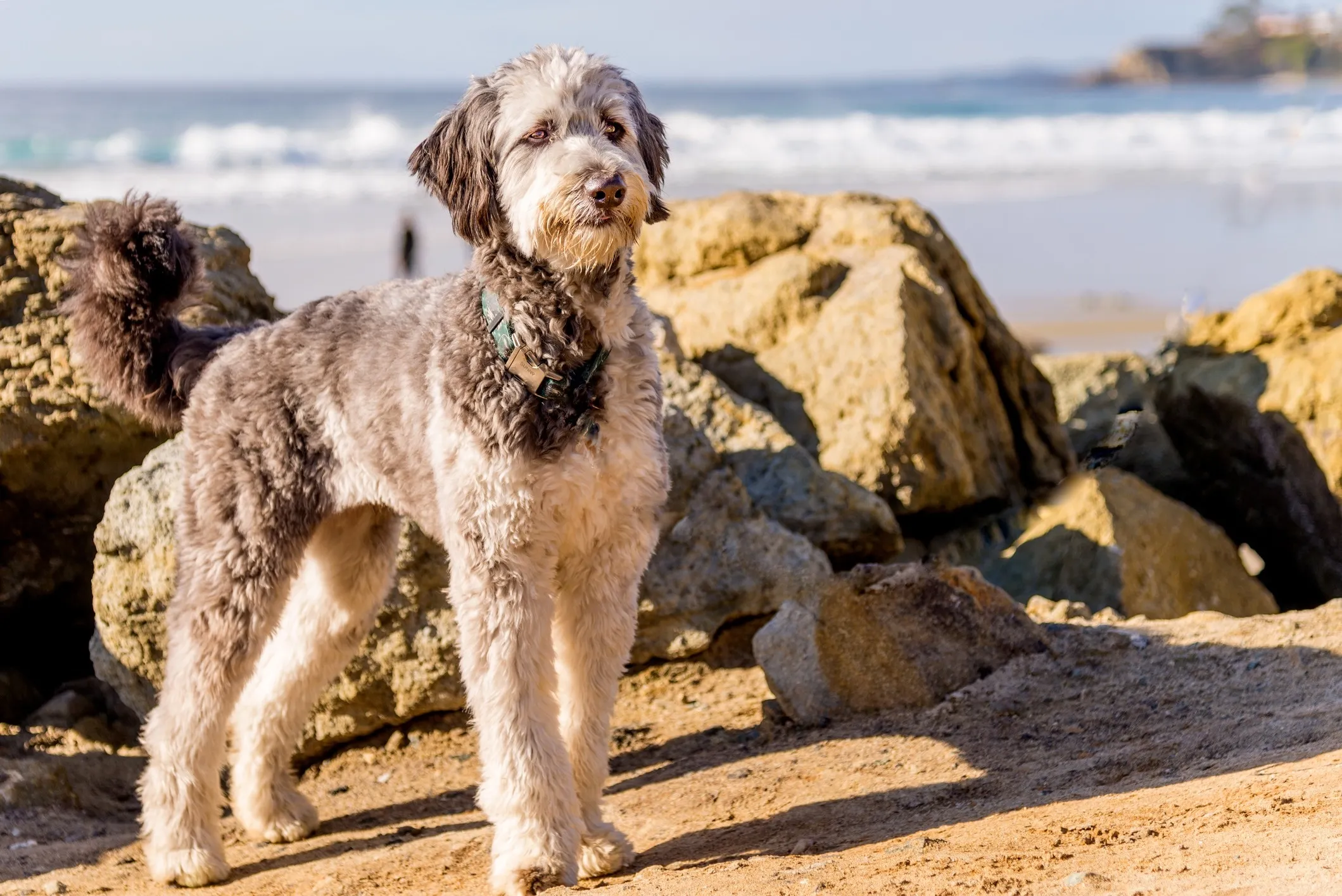 Standard Aussiedoodle dog standing proudly on a beach with water in the background
Standard Aussiedoodle dog standing proudly on a beach with water in the background
An Aussiedoodle is a crossbreed between an Australian Shepherd and a Poodle. While their size can vary depending on the Poodle parent (Standard or Miniature), medium-sized Aussiedoodles are popular for their intelligence, energy, and low-shedding coats. They often inherit the Poodle’s curly, low-shedding coat and the Australian Shepherd’s keen intellect and loyalty.
- Size: Medium Aussiedoodles typically weigh 25-50 pounds and stand 18-23 inches tall.
- Temperament: Highly intelligent, energetic, and affectionate. They thrive on mental stimulation and physical activity. Without sufficient exercise, they can become bored and potentially destructive.
- Grooming: Their wavy to curly coat needs regular brushing (several times a week) to prevent matting and professional grooming every 6-8 weeks.
8. Labradoodle (Medium Variants)
 Brown Standard Labradoodle walking gracefully through a park with trees
Brown Standard Labradoodle walking gracefully through a park with trees
The Labradoodle, a cross between a Labrador Retriever and a Poodle, was originally bred to be a hypoallergenic service dog. Medium Labradoodles combine the friendly, outgoing nature of the Labrador with the Poodle’s intelligence and low-shedding coat. They are known for being affectionate, trainable, and generally excellent family dogs that don’t shed much.
- Size: Medium Labradoodles typically weigh 30-45 pounds and stand 17-20 inches tall.
- Temperament: Friendly, intelligent, and gentle. They are highly trainable and enjoy being part of family activities. Early socialization is beneficial for their development.
- Grooming: Their coat can range from wavy to curly and requires regular brushing (2-3 times a week) and professional grooming every 6-8 weeks to prevent mats.
9. Goldendoodle (Medium Variants)
 Goldendoodle lying comfortably on a couch with a person sitting in the background
Goldendoodle lying comfortably on a couch with a person sitting in the background
Similar to the Labradoodle, the Goldendoodle is a popular “doodle” breed, a mix of a Golden Retriever and a Poodle. Medium Goldendoodles inherit the Golden Retriever’s friendly, devoted nature and the Poodle’s intelligence and low-shedding qualities. They are known for their charming personalities and adaptability.
- Size: Medium Goldendoodles typically weigh 30-45 pounds and stand 17-20 inches tall.
- Temperament: Sociable, intelligent, and affectionate. They are generally good with children and other pets, making them ideal family companions.
- Grooming: Their wavy to curly coat needs frequent brushing (several times a week) and regular professional grooming to prevent matting.
10. Schnoodle (Medium Variants)
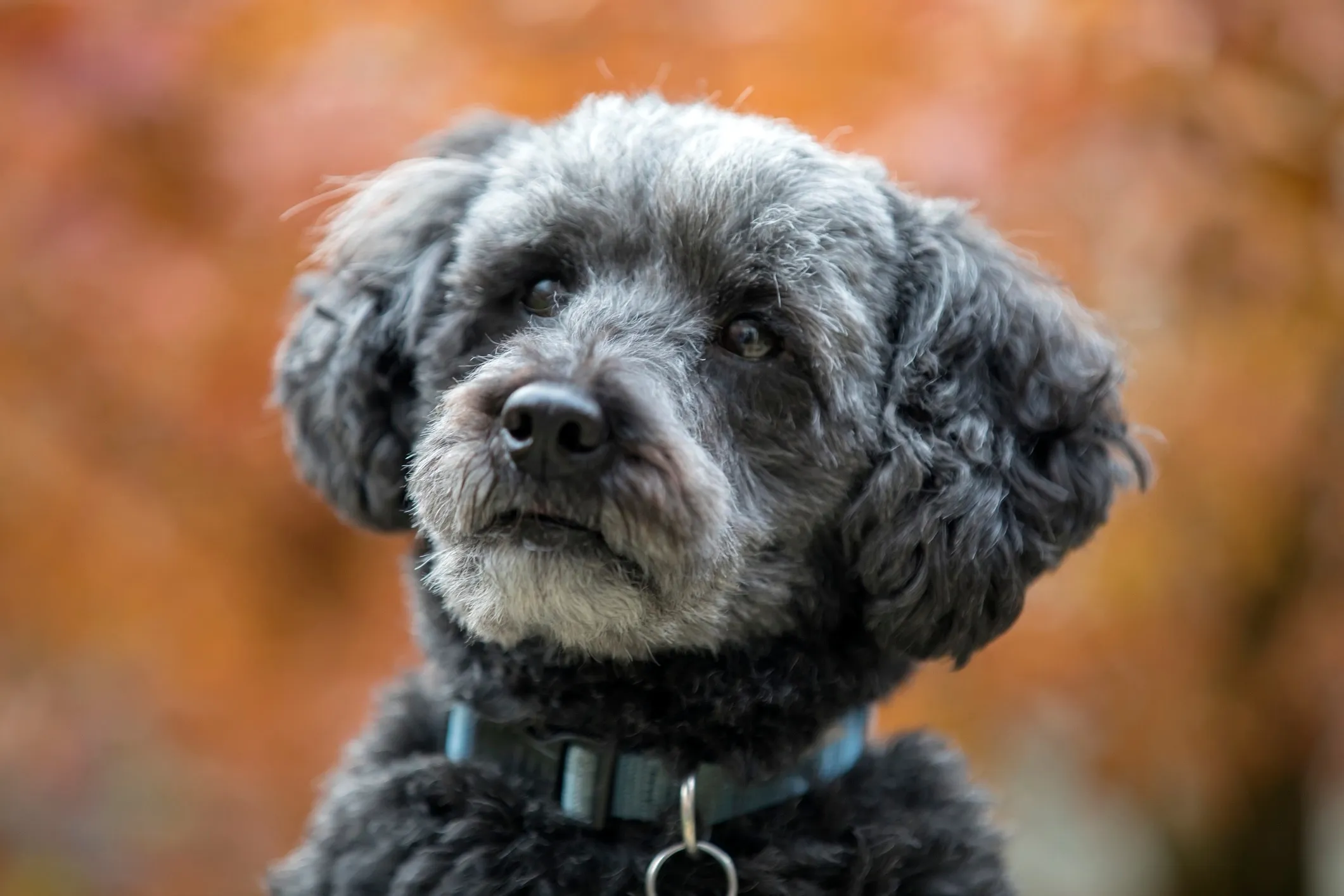 Close-up of a gray Schnoodle dog with curly fur and soulful eyes
Close-up of a gray Schnoodle dog with curly fur and soulful eyes
A Schnoodle is a delightful cross between a Schnauzer (Miniature or Standard) and a Poodle. This combination often results in a dog with a low-shedding coat and a lively, intelligent personality. Medium Schnoodles benefit from the robust nature of the Schnauzer and the Poodle’s smarts.
- Size: Medium Schnoodles, typically from a Standard Schnauzer and Miniature or Standard Poodle mix, can weigh 20-45 pounds and stand 15-20 inches tall.
- Temperament: Playful, intelligent, and loyal. They are typically good with families but benefit from consistent training due to their energetic and sometimes stubborn nature.
- Grooming: Their coat can be wavy or curly, requiring regular brushing (2-3 times a week) and professional grooming every few months.
11. Whoodle
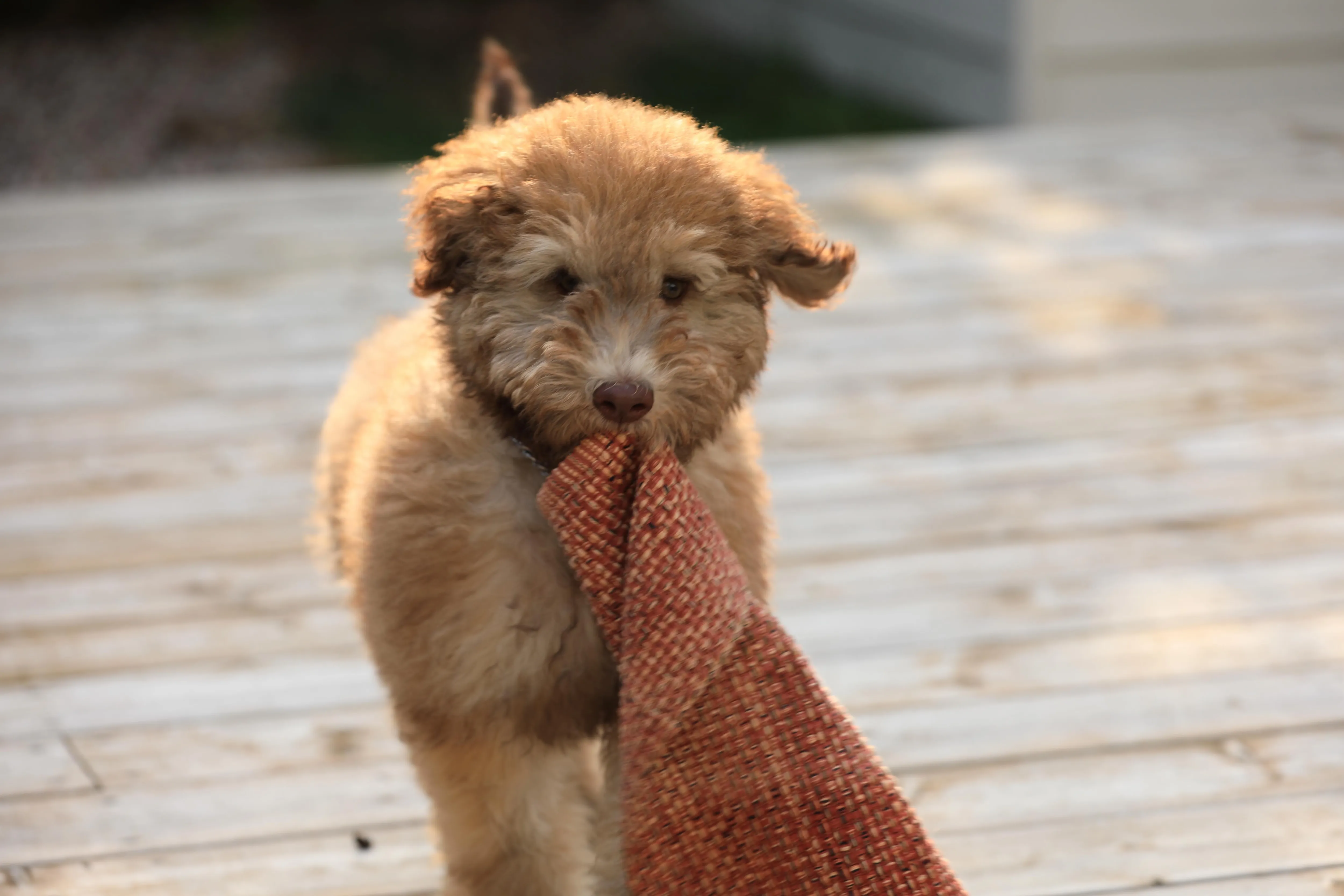 Tan Whoodle puppy dragging a washcloth, looking playfully at the camera
Tan Whoodle puppy dragging a washcloth, looking playfully at the camera
The Whoodle is a charming hybrid resulting from crossing a Soft Coated Wheaten Terrier with a Poodle. This mix brings together two low-shedding breeds, virtually guaranteeing a minimal-shedding coat. Whoodles are known for their friendly demeanor, intelligence, and playful spirit, making them fantastic companions.
- Size: Whoodles typically weigh 20-40 pounds and stand 17-20 inches tall.
- Temperament: Affectionate, intelligent, and spirited. They enjoy being part of family activities and require regular exercise and mental stimulation.
- Grooming: Their wavy to curly coat needs frequent brushing to prevent tangles and mats, along with professional grooming every 6-8 weeks.
12. Bernedoodle (Medium/Mini Variants)
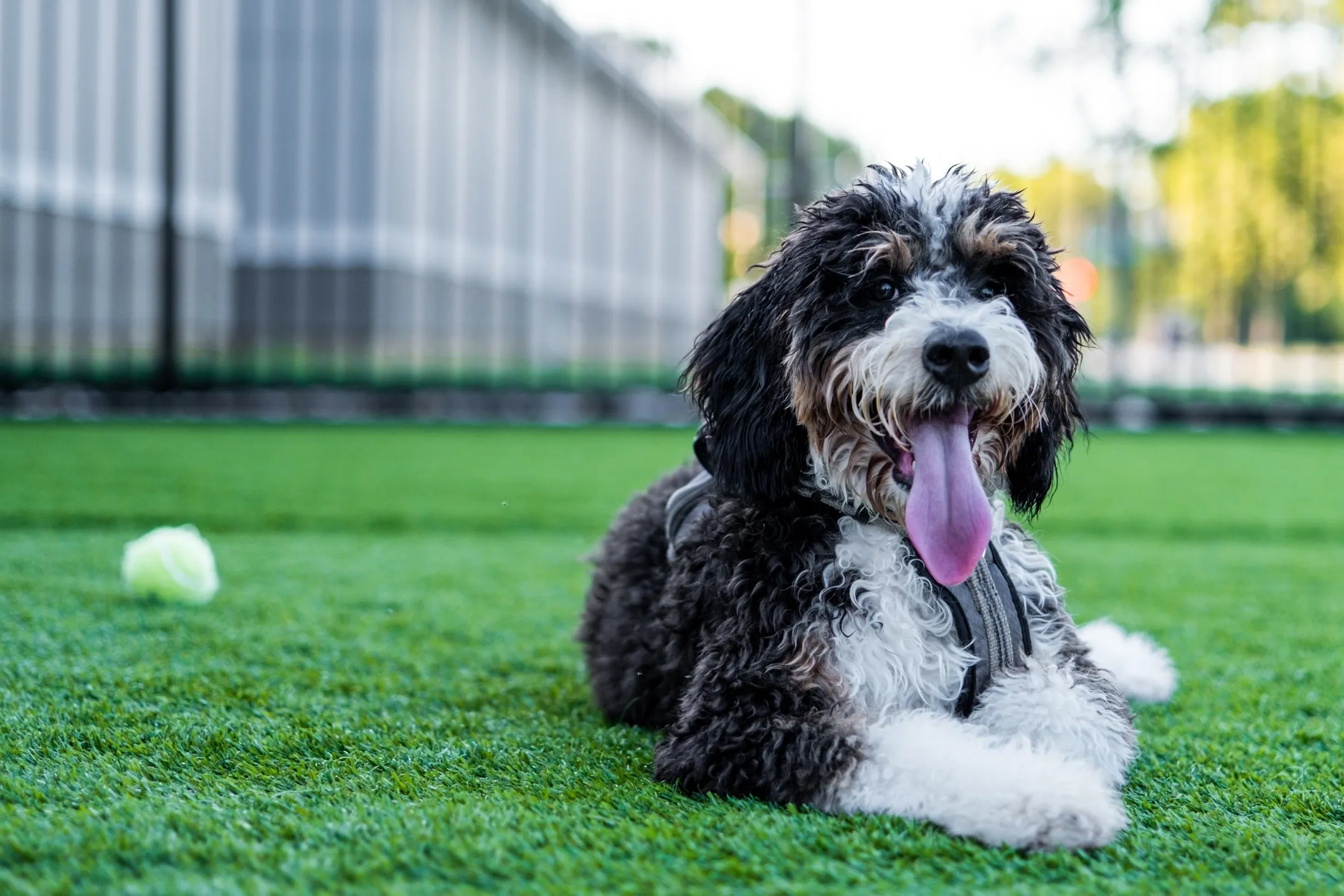 Large Bernedoodle dog lying contentedly in grass with its tongue out
Large Bernedoodle dog lying contentedly in grass with its tongue out
A Bernedoodle is a cross between a Bernese Mountain Dog and a Poodle. While Standard Bernedoodles can be quite large, Mini Bernedoodles are specifically bred to be smaller, fitting into the medium-sized category. They are known for their gentle, affectionate nature and distinct tricolor coats, combining the best traits of both parent breeds.
- Size: Mini Bernedoodles typically weigh 25-50 pounds and stand 18-22 inches tall.
- Temperament: Calm, affectionate, and intelligent. They are excellent with children and other pets, making them superb family companions. They enjoy being active but are not overly demanding.
- Grooming: Their wavy to curly coat requires regular brushing (several times a week) and professional grooming every 6-8 weeks to prevent matting.
13. Afghan Hound
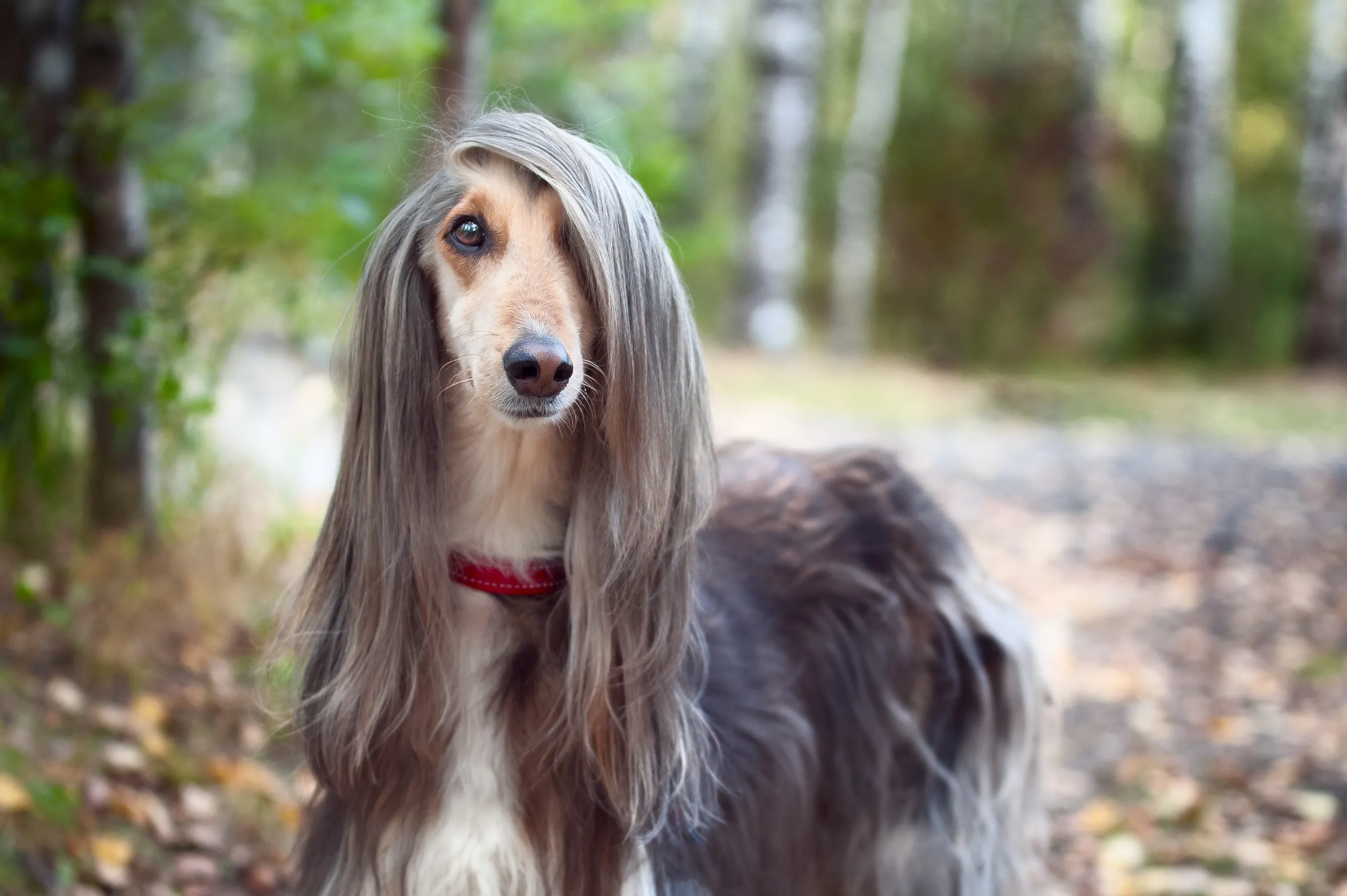 Gray and tan Afghan Hound looking intently at the camera, showcasing its elegant, flowing coat
Gray and tan Afghan Hound looking intently at the camera, showcasing its elegant, flowing coat
The Afghan Hound is an aristocratic and strikingly beautiful breed, renowned for its long, flowing, silky coat. While their grooming needs are extensive, their single coat sheds very little, making them a suitable option for some allergy sufferers. These dogs are independent, dignified, and incredibly fast.
- Size: Afghan Hounds typically weigh 50-60 pounds and stand 25-27 inches tall. While tall, their slender build often keeps them within the higher end of a medium weight range.
- Temperament: Independent, aloof with strangers, but loyal and affectionate with their families. They require extensive exercise due to their sighthound heritage and benefit from early, consistent socialization.
- Grooming: Their luxurious coat requires daily brushing and regular bathing to prevent mats and keep it clean and healthy.
14. Barbet
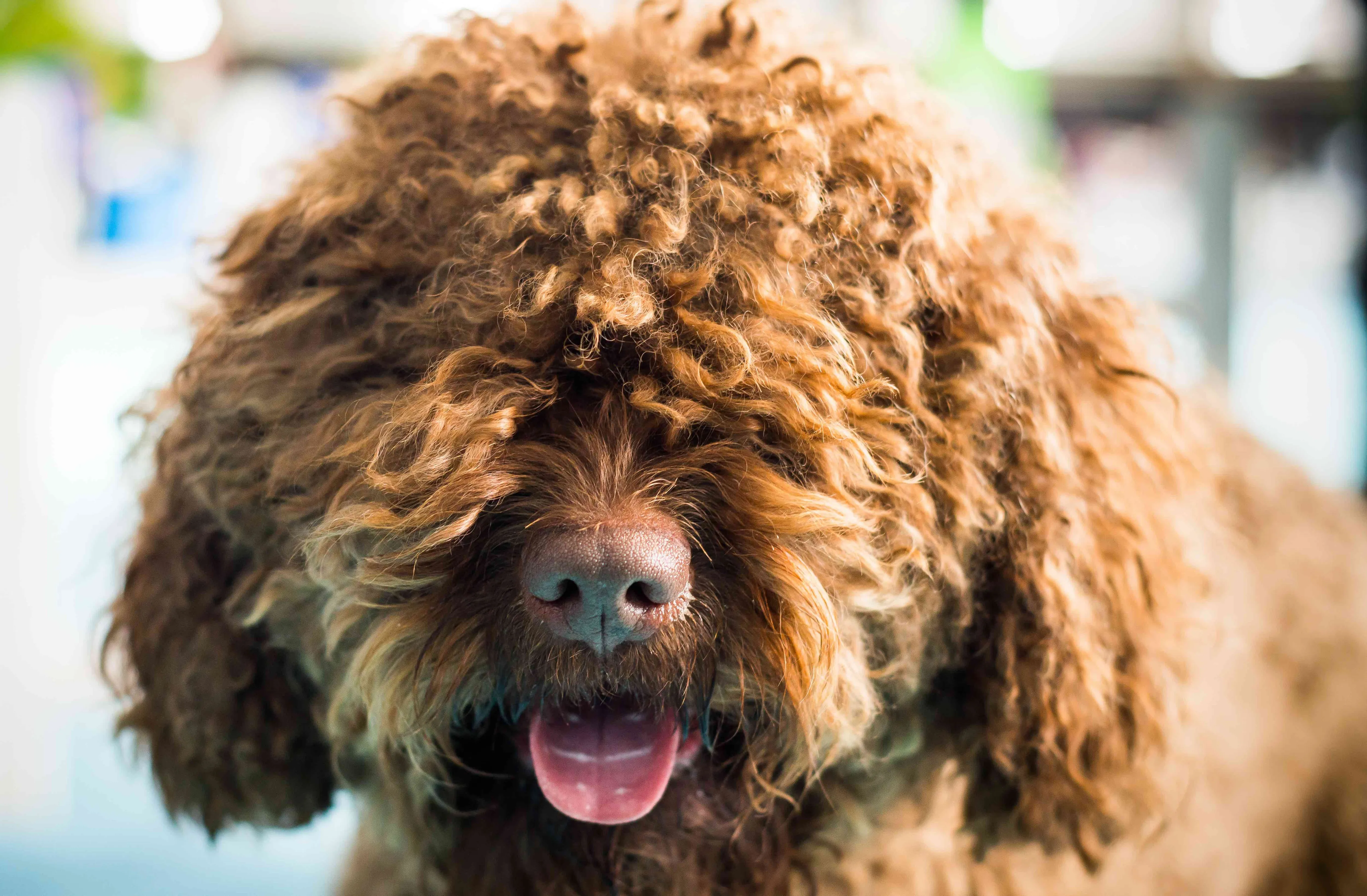 Close-up of a curly red Barbet dog's face, showing its characteristic beard
Close-up of a curly red Barbet dog's face, showing its characteristic beard
The Barbet, a cheerful French water dog, has a shaggy, woolly coat that is dense and curly, similar to a Poodle’s, and sheds minimally. Their name, derived from the French word “barbe” (beard), perfectly describes their distinctive facial hair. These dogs are friendly, intelligent, and love to swim.
- Size: Barbets typically weigh 35-65 pounds and stand 19-24 inches tall.
- Temperament: Loyal, intelligent, and good-natured. They are eager to please and thrive on being involved in family activities, especially those involving water. They need consistent exercise and training.
- Grooming: Their woolly coat needs regular brushing (2-3 times a week) and occasional trimming to prevent matting, particularly after swimming.
15. Peruvian Inca Orchid (Medium Hairless Variant)
 Peruvian Inca Orchid dog, showcasing its hairless body and alert expression
Peruvian Inca Orchid dog, showcasing its hairless body and alert expression
The Peruvian Inca Orchid is an ancient and rare breed known for its striking hairless (or sometimes short-coated) body. The hairless variety is naturally hypoallergenic due to the lack of fur and dander. These dogs come in three sizes, with the medium variant being an ideal low-shedding option. They are elegant, agile, and protective of their families.
- Size: The medium Peruvian Inca Orchid typically weighs 17-27 pounds and stands 15-20 inches tall.
- Temperament: Alert, affectionate, and sometimes reserved with strangers. They form strong bonds with their families and can be very protective. They require regular exercise and early socialization.
- Grooming: Hairless varieties need skin care, including moisturizing and sun protection, while short-coated varieties require minimal brushing.
When considering which of these exceptional medium sized dog breeds don’t shed, remember that each breed has its unique personality and needs. Researching their specific exercise, training, and social requirements will ensure a perfect match for your lifestyle.
Living with a Medium-Sized, Low-Shedding Dog: Essential Tips
Bringing a low-shedding, medium-sized dog into your home is a fantastic step towards managing allergies while enjoying canine companionship. However, it’s not just about the dog; your environment and routine play a significant role too. Here are key tips for a successful and allergy-friendly living arrangement:
1. Grooming is Key (Even for Non-Shedders)
While these breeds shed minimally, their continuous-growing coats require dedicated grooming to prevent matting and remove trapped dander and loose hairs.
- Regular Brushing: Brush your dog several times a week, or even daily for breeds with very curly or long coats (like the Afghan Hound). This helps remove loose hair and dander before it disperses into your home.
- Bathing: Bathe your dog every 4-6 weeks using a mild, dog-specific shampoo. This washes away accumulated dander and allergens from their skin and coat. Products designed to reduce pet dander can also be beneficial.
- Professional Grooming: Many low-shedding breeds require professional trimming or clipping every 6-12 weeks to maintain coat health and length. Factor this into your budget or learn proper at-home grooming techniques.
2. Maintaining a Clean Home Environment
Minimizing allergens in your home is crucial, especially when living with a pet, even a low-shedding one.
- Vacuum Frequently: Use a vacuum cleaner with a HEPA filter on carpets, rugs, and upholstery.
- Dust Regularly: Dust surfaces with a damp cloth to capture allergens rather than just spreading them around.
- Wash Bedding: Regularly wash pet bedding, your own bedding, and any throws or blankets your dog uses.
- Air Purifiers: Consider using high-efficiency particulate air (HEPA) filters or air purifiers in rooms where your dog spends the most time.
- Designated Dog-Free Zones: Designate certain areas, like bedrooms, as dog-free zones to create allergen-reduced sanctuaries.
3. Understanding Exercise and Training Needs
Medium-sized dogs are typically active and intelligent. To ensure a well-behaved and happy companion, consistent exercise and mental stimulation are vital.
- Daily Exercise: Most breeds on this list require at least 60 minutes of vigorous exercise daily. This could include walks, runs, playtime in a securely fenced yard, or dog sports.
- Mental Stimulation: Intelligent breeds thrive on puzzle toys, training sessions, and interactive games. A tired dog, both physically and mentally, is generally a happy and well-behaved dog.
- Training: Positive reinforcement training is essential for all dogs. It helps build a strong bond and ensures your dog understands boundaries and commands.
4. Consulting Your Doctor for Allergies
If you or a family member has dog allergies, it’s wise to consult with a healthcare provider.
- Allergy Management: Your doctor can provide advice on managing allergy symptoms, suggest appropriate medications (antihistamines, nasal sprays), or discuss immunotherapy options (allergy shots).
- Testing: If you’re unsure about the specific allergens causing your reaction, allergy testing can pinpoint triggers, helping you make informed decisions.
- Trial Period: If possible, spend time with the specific breed you’re considering before committing. Visit a breeder or rescue, or foster a dog to see how your allergies react. This is part of finding the best dog to get that doesn’t shed for your unique situation.
Living with a medium-sized dog that doesn’t shed hair can bring immense joy and companionship, even for allergy sufferers. By understanding the nature of “hypoallergenic” breeds and implementing a consistent routine of grooming and home maintenance, you can create a comfortable and loving environment for everyone. These breeds offer the perfect blend of manageability and affectionate companionship, making them a fantastic choice for many households. If you’re also looking for a guardian, there are also wonderful protective dog breeds that don’t shed.
Embrace the journey of finding your perfect furry friend, and prepare for a lifetime of happy, sneeze-free memories!
